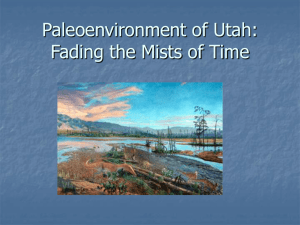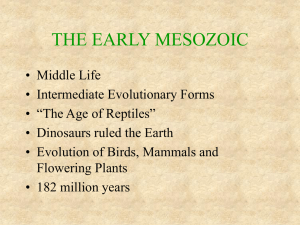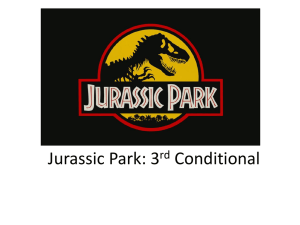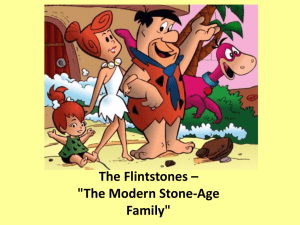Mesozoic Era: Age of Reptiles - Dinosaurs & Extinction
advertisement
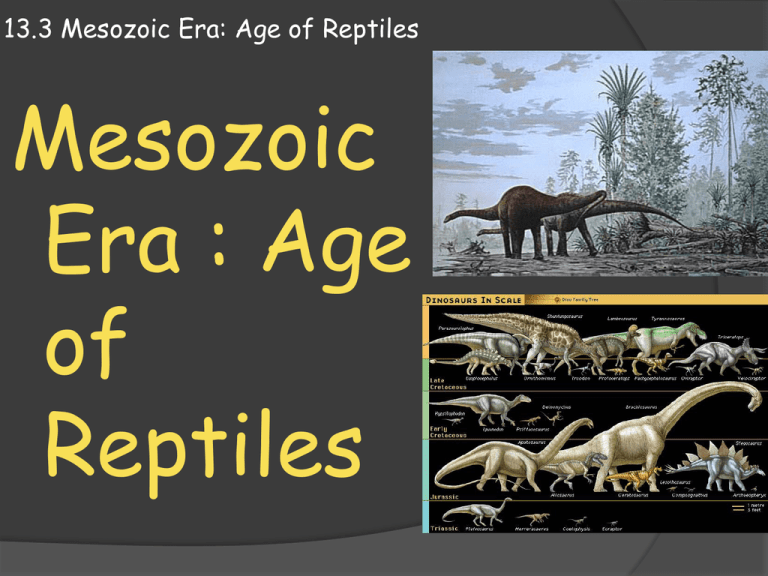
13.3 Mesozoic Era: Age of Reptiles Mesozoic Era : Age of Reptiles Mesozoic Era : 251 – 65 After the Permian extinction, millions of years passed before the number and diversity of living things began to rise again. One group that became very successful and diverse was the ammonites. These extinct mollusks were related to squid and octopus. Ammonites have distinct spiral shells; each type of ammonite having a slightly different shell. Mesozoic Era : Age of reptiles There were many changes in oceans during the Mesozoic era. As a result, many different types of ammonites evolved and became extinct after a few million years. For this reason, they make excellent index fossils. Ammonite index fossils help geologists date sedimentary rock layers from the different periods of the Mesozoic: the Triassic, Jurassic and Cretaceous. Triassic period ( 251 - 200 ) Pangaea continued as a single, large landmass through most of the Triassic period. (251 – 200 million) After a slow recovery from the Permian extinction, many kinds of reptiles evolved. Late in the period, the first mammals appeared. Several important new types of organisms evolved during the Triassic. For example, the first dinosaurs were among the many types of reptiles that evolved. Triassic period ( 251 - 200 ) Most landmasses were fused together in the supercontinent Pangaea during the Triassic. A huge ocean called Panthalassa (meaning “all sea”) occupied the rest of earth’s surface. In the interior of Pangaea, climates on land varied greatly from season to season. Pangaea had hot summers and cold winters, similar to those in the interior of North America or Asia today. Triassic period ( 251 - 200 ) Triassic Earth: Toward the end of the Triassic, Pangaea began to split apart slowly. The split began as Africa pulled away from North and South America. The breakup of Pangaea continues today, about 200 million years later. Triassic period ( 251 - 200 ) Triassic Life: Several important new types of organisms evolved during the Triassic. For example, the first dinosaurs were among the many types of reptiles that evolved. Later in the Triassic, the first mammals evolved from a surviving group of mammal-like reptiles. Unlike reptiles, most mammals do not lay eggs. Mammals are warmblooded animals that nourish their young with milk. Triassic mammals, such as Megazostrodon were small rodent-like animals. First mammals: megazostrodon Triassic period ( 251 - 200 ) Triassic Life: The fossil record shows that gymnosperms became common during the Triassic. Gymnosperms are a group of plants with seeds that lack a protective outer coat. Unlike sporebearing plants, gymnosperms do not require standing water, such as dew, in their reproductive cycle. For this reason, they can use nutrients and occupy space in drier areas. conifers Conifers, which first appeared during the Permian period, are gymnosperms. Other gymnosperms include cycads and ginkgoes. cycads Jurassic period ( 200 -145 ) Jurassic period: (200 – 145) As rifts formed between parts of Pangaea, seas opened between continents. At the same time, mountain building occurred in some areas, such as western North America. There, the North American plate moved west over the oceanic plate. Tectonic activity started a wave of deformation that moved inland along the entire western part of the continent. Jurassic period ( 200 -145 ) Jurassic period: (200 – 145) The newly formed Jurassic seas helped to moderate the harsh climate conditions of Pangaea. Generally, climates were mild at all latitudes during the Jurassic. Warmer conditions contributed to the development of new life forms. Jurassic period ( 200 -145 ) Jurassic Life: (200 – 145) New developments occurred in the oceans, on land, and in the air during the Jurassic. In the oceans, fish with modern characteristics evolved. Their jaw structure, scales, and fins were similar to those of fish today. Reptiles adapted to life in the oceans. Fish eating plesiosaurs and ichthyosaurs became good swimmers but kept reptilian teeth and breathed by means of lungs. Jurassic period ( 200 -145 ) Jurassic Life: (200 – 145) During the Jurassic period, dinosaurs developed into a varied and widespread group. Some dinosaurs, such as Diplodocus, Brachiosaurus, and Stegosaurus were plant eaters. Meat eating dinosaurs of the Jurrasic included Allosaurus. diplodocus Jurassic period ( 200 -145 ) Evolution of Birds During the Jurassic, pterosaurs evolved. These flying reptiles had “wings” formed from membranes of skin attached to their forelegs. But scientists think that birds developed from dinosaurs. In fact, some dinosaurs had feathers. The feathers may have served for display or to help regulate body temperature. Jurassic period ( 200 -145 ) Evolution of Birds The early ancestors of birds were probably small, feathered dinosaurs that could glide. Later, more birdlike animals, like Archaepteryx evolved. Archaepteryx still had reptile like teeth, claws on it’s wings, and a tail. It lacked the large breastbone that modern birds have to anchor flight muscles, but it could fly short distances. Cretaceous period ( 145 - 65 ) Cretaceous period: The landmasses that had made up Pangaea continued to move apart during the Cretaceous period. At the same time, Earth’s climates continued to be relatively warm. Early in the Cretaceous, shallow seas invaded much of the western North America. These shallow seas created great swamps like those of the Paleozoic era. The swamps formed the Cretaceous coal deposits of the western United States and Canada. Cretaceous period ( 145 - 65 ) Cretaceous Life: Dinosaurs of the Cretaceous period evolved many different sizes, shapes, and ways of living. Large slow moving plant eaters waded on four legs in the shallows of swampy areas. Smaller, faster, meat-eaters ran on two hind legs. The Cretaceous was the time of the fierce Tyrannosaurus rex, the horned Triceratops and gigantic plant eaters like Apatosaurus. Cretaceous period ( 145 - 65 ) Cretaceous Life: Other animals groups also appeared and flourished. Snakes evolved early in the Cretaceous. Mammals with more modern characteristics evolved. Flowering plants, or angiosperms, also evolved during this period. Angiosperms are plants that produce flowers and seeds with an outer covering. Many modern angiosperms; include trees such as willow, birch, and sassafras, evolved and became common during the Cretaceous. sassafras Weeping willow Cretaceous period ( 145 - 65 ) Cretaceous Extinction: About 65 million years ago, the Cretaceous period ended in a mass extinction. The dinosaurs and most other large animals became extinct. Smaller reptiles, birds and reptiles were also affected, with some species of these surviving. In the oceans, ammonites were among the species that became extinct. Cretaceous period ( 145 - 65 ) Cretaceous Extinction: Most scientists think that a large meteorite collided with earth and caused the mass extinction. The collision would have created huge quantities of dust that blocked out the sun, perhaps for years. This in turn caused plants to die and food to vanish for many dinosaurs. With the plant eating dinosaurs perishing, the meat eating dinosaurs would thus have no food as well. Cretaceous period ( 145 - 65 ) Cretaceous Extinction: Another hypothesis to explain the Cretaceous extinction is that huge volcanic eruptions in India may have led to climate changes. Some scientists think that disease may have wiped out the dinosaurs pointing to a decline in species even before the mass extinction. It is likely that several factors combined together to create the Cretaceous extinction.

